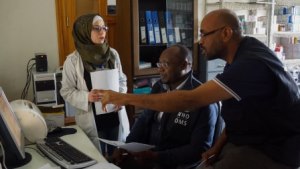 3 April 2017 – WHO has conducted an assessment of Syria’s Early Warning Alert and Response System (EWARS) to review the system’s functionality, evaluate its ability to detect, confirm and respond to disease outbreaks, and provide recommendations for improvements.
3 April 2017 – WHO has conducted an assessment of Syria’s Early Warning Alert and Response System (EWARS) to review the system’s functionality, evaluate its ability to detect, confirm and respond to disease outbreaks, and provide recommendations for improvements.
The mission team was composed of experts from WHO’s Regional Office for the Eastern Mediterranean who teamed up with national counterparts to assess more than 30 health facilities and 14 laboratories in 10 governorates across the country over a 2-week period (March 5–19, 2017). Despite insecurity and movement restrictions, the assessment team met the EWARS focal points – surveillance staff, data managers and clinical staff at the central, governorate, district and health facility level – to conduct interviews and observe the surveillance process directly.
Since its inception, EWARS in Syria has expanded from 104 sentinel sites in 2012 to 1112 sites in 2017, with 28% of reporting sites located in hard-to-reach areas. This is the first assessment of its kind since EWARS and epidemic readiness measures were established in Syria in 2012.
One of the main findings of the assessment team was the successful establishment of trained rapid response teams in all 10 governorates, who are well prepared to investigate and respond to events of public health importance.
Another highlight was the establishment of electronic data entry systems since 2015 in all reporting governorates and around 5 out of 11 districts. The move from paper-based systems to electronic data entry has improved the quality and accessibility of data collected, further enhancing the country’s surveillance capabilities. Surveillance focal points from the Ministry of Health and local non-governmental organizations report on a regular basis, and all surveillance sites are well-equipped with the required tools and trained staff.
The collaborative efforts of the Ministry of Health, local authorities, WHO and health partners have contributed to the success of Syria’s EWARS systems for outbreak investigation and response. All stakeholders interviewed stated that they found EWARS useful for monitoring health trends and early outbreak detection and response.
The crisis in Syria has adversely affected its health system. More than half of the country’s health care facilities are either completely out of service or only partially functioning, and face critical shortages in life-saving and essential medicines. An estimated 5 million people are internally displaced and at a greater risk of contracting infectious diseases, creating challenges in health containment measures.
The EWARS assessment mission was based on a joint initiative between the Ministry of Health, WHO and the Centers for Disease Control (CDC). In the coming weeks, WHO will hold a consultative meeting with all stakeholders to agree on the mission recommendations, and develop a strategic action plan for disease surveillance and response in Syria for the coming 2 to 3 years.


